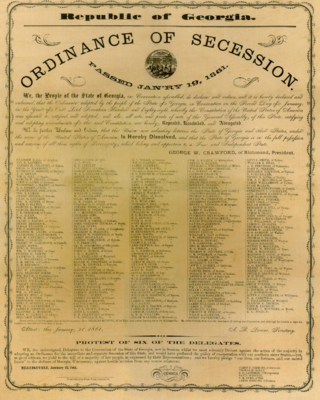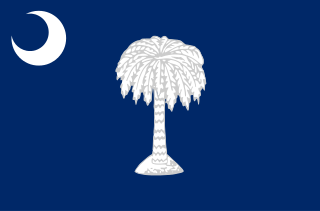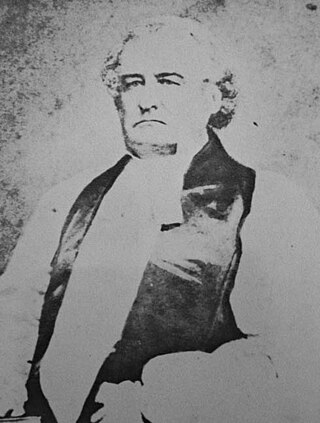
The Confederate States of America (CSA), commonly referred to as the Confederate States or the Confederacy, was an unrecognized breakaway herrenvolk republic in the Southern United States that existed from February 8, 1861, to May 9, 1865. The Confederacy comprised U.S. states that declared secession and warred against the United States during the American Civil War: South Carolina, Mississippi, Florida, Alabama, Georgia, Louisiana, Texas, Virginia, Arkansas, Tennessee, and North Carolina.

Jones County is in the southeastern portion of the U.S. state of Mississippi. As of the 2020 census, the population was 67,246. Its county seats are Laurel and Ellisville.

This section of the Timeline of United States history concerns events from 1860 to 1899.

In the context of the American Civil War (1861–65), the border states were slave states that did not secede from the Union. They were Delaware, Maryland, Kentucky, and Missouri, and after 1863, the new state of West Virginia. To their north they bordered free states of the Union and all but Delaware bordered slave states of the Confederacy to their south.

The flag of South Carolina is a symbol of the U.S. state of South Carolina consisting of a blue field with a white palmetto tree and white crescent. Roots of this design have existed in some form since 1775, being based on one of the first American Revolutionary War flags. While keeping most of its design intact since its adoption, it has varied over the years.
The 1860–61 United States House of Representatives elections were held on various dates in various states between August 6, 1860 and October 24, 1861, before or after the first session of the 37th United States Congress convened on July 4, 1861. The number of House seats initially increased to 239 when California was apportioned an extra one, but these elections were affected by the outbreak of the American Civil War and resulted in over 56 vacancies.

An Ordinance of Secession was the name given to multiple resolutions drafted and ratified in 1860 and 1861, at or near the beginning of the Civil War, by which each seceding Southern state or territory formally declared secession from the United States of America. South Carolina, Mississippi, Georgia, and Texas also issued separate documents purporting to justify secession.

Milledge Luke Bonham was an American politician and Congressman. He was later the 70th Governor of South Carolina from 1862 until 1864, and a Confederate General during the American Civil War.

Francis Wilkinson Pickens was a political Democrat and Governor of South Carolina when that state became the first to secede from the United States.

The South Carolina Declaration of Secession, formally known as the Declaration of the Immediate Causes Which Induce and Justify the Secession of South Carolina from the Federal Union, was a proclamation issued on December 24, 1860, by the government of South Carolina to explain its reasons for seceding from the United States. It followed the brief Ordinance of Secession that had been issued on December 20. The declaration is a product of a convention organized by the state's government in the month following the election of Abraham Lincoln as U.S. President, where it was drafted in a committee headed by Christopher Memminger. The declaration stated the primary reasoning behind South Carolina's declaring of secession from the U.S., which was described as "increasing hostility on the part of the non-slaveholding States to the Institution of Slavery". The Declaration states, in part, "A geographical line has been drawn across the Union, and all the States north of that line have united in the election of a man to the high office of President of the United States, whose opinions and purposes are hostile to slavery."

South Carolina was the first state to secede from the Union in December 1860, and was one of the founding member states of the Confederacy in February 1861. The bombardment of the beleaguered U.S. garrison at Fort Sumter in Charleston Harbor on April 12, 1861 is generally recognized as the first military engagement of the war. The retaking of Charleston in February 1865, and raising the flag again at Fort Sumter, was used for the Union symbol of victory.

Charleston, South Carolina, was a hotbed of secession at the start of the American Civil War and an important Atlantic Ocean port city for the fledgling Confederate States of America. The first shots against the Federal government were those fired there by cadets of the Citadel to stop a ship from resupplying the Federally held Fort Sumter. Three months later, the bombardment of Fort Sumter triggered a massive call for Federal troops to put down the rebellion. Although the city and its surrounding fortifications were repeatedly targeted by the Union Army and Navy, Charleston did not fall to Federal forces until the last months of the war. Charleston was devastated.

States Rights Gist was a lawyer, a militia general in South Carolina, and a Confederate Army brigadier general who served during the American Civil War. A relative of several prominent South Carolinians, Gist rose to fame during the war but was killed at the Battle of Franklin on November 30, 1864. His name was based on the Southern states’ rights doctrine of nullification politics of his father, Nathaniel Gist. Nathaniel Gist was a disciple of John C. Calhoun and chose his son's name to reflect his own political sentiments.
John Morgan Landrum was a Democratic U.S. Representative from Louisiana serving in the 36th Congress. Shortly after Louisiana seceded from the Union in January 1861, Landrum vacated his seat.

In the context of the United States, secession primarily refers to the voluntary withdrawal of one or more states from the Union that constitutes the United States; but may loosely refer to leaving a state or territory to form a separate territory or new state, or to the severing of an area from a city or county within a state. Advocates for secession are called disunionists by their contemporaries in various historical documents.

The following outline is provided as an overview of and topical guide to South Carolina:

The Protestant Episcopal Church in the Confederate States of America was an Anglican Christian denomination which existed from 1861 to 1865. It was formed by Southern dioceses of the Episcopal Church in the United States during the American Civil War. When the Southern states seceded from the Union and established the Confederate States of America, it was not unusual for Protestant churches to split along national lines also. The Episcopalians were different as their separation was made only after the Confederacy was created and ended within six months of the South's surrender when Southern Episcopalians reunited with their counterparts in the North.
Events from the year 1861 in the United States. This year marked the beginning of the American Civil War.
Submissionist was a derogatory term used by Southern secessionists in the year preceding the American Civil War to describe Southerners who wanted to preserve the Union. Before 1861, Southerners loyal to the Union were generally respected as principled idealists. As Southern states began to actually secede, however, those who had seceded viewed Southerners who remained Unionists as cowardly and lacking the strength to stand up for their own rights. Following the Secession Crisis, popular sentiment in the Deep South held that the North was unwilling to compromise with the South. The Deep South would rather secede from the Union than relinquish sovereignty. Consequently, "submissionist" was a derogatory name for a Southerner who would seemingly relinquish sovereignty in order to remain in the Union.
The Confederate States of America was created on February 8, 1861, by representatives from six states that had recently declared their secession from the United States of America, starting with South Carolina on December 20, 1860. After the start of the American Civil War on April 12, 1861, between the two countries, five additional states would secede, and representatives of two others would gain admittance to the Confederacy. The country also held alliances with several Indian nations and claimed a territory in its far west. However, after its swift formation, it would only lose control over its territory over the next four years, culminating in total defeat in early 1865 and the formal dissolution of the government on May 5. The entire claimed area of the Confederate States was claimed by the United States.













